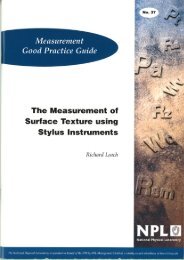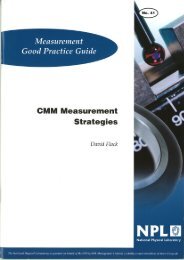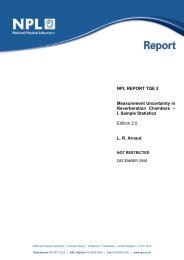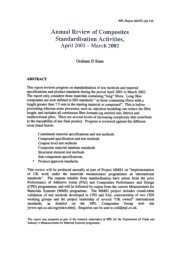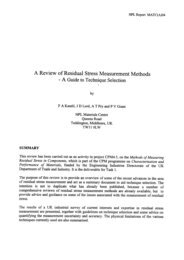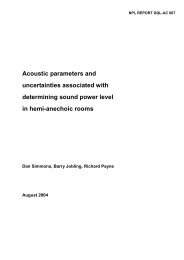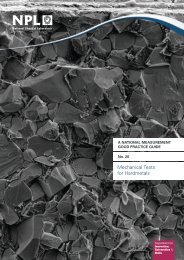Dimensional Measurement using Vision Systems - NPL Publications ...
Dimensional Measurement using Vision Systems - NPL Publications ...
Dimensional Measurement using Vision Systems - NPL Publications ...
You also want an ePaper? Increase the reach of your titles
YUMPU automatically turns print PDFs into web optimized ePapers that Google loves.
<strong>Measurement</strong> Good Practice Guide No. 39<br />
While temporal coherence describes the phase relation in the direction of the light beam,<br />
spatial coherence describes the phase relation in a plane perpendicular to the direction of<br />
propagation. Thus, in considering the resolution of two point sources by the optical<br />
microscope in Section 2 it was assumed that there was no fixed phase relationship existing<br />
between the light waves emanating from these two points. The resultant intensity<br />
distribution in the image plane is then determined by the simple addition of each intensity<br />
pattern as shown in Figure 3.<br />
However, in microscopy, objects are usually illuminated by light from the condenser.<br />
Thus, the two point objects should be regarded as two pinholes in an otherwise opaque<br />
film. If some of the light passing through each pinhole has originated from the same<br />
incident wave train, there will be a degree of spatial coherence between the waves from<br />
the pinholes. Now each point in the field stop will be imaged by the condenser as an Airy<br />
disc in the object plane, with the diameter of each disc increasing as the condenser<br />
numerical aperture is reduced. Thus the coherently illuminated area and hence the degree<br />
of spatial coherence in the illumination of two pinholes will increase with decreasing<br />
condenser aperture.<br />
Theoretical analysis, taking spatial coherence into account, has shown that the minimum<br />
resolvable pinhole separation (based on the intensity criterion used in Section 2.1) is given<br />
by equation (1) for equal objective and condenser apertures, but with decreasing<br />
condenser NA it rises rather more slowly than expected from the Abbe rule (based on the<br />
mean of the objective and condenser apertures).<br />
It is therefore evident that an objective of high numerical aperture is essential to achieve<br />
maximum resolution. Expressed in a different way, increasing the objective NA results in<br />
a higher proportion of light diffracted by the object that is collected by the objective and<br />
hence, the greater the similarity between object and image. Although in theory the<br />
condenser NA should be comparable to the objective aperture to achieve highest<br />
resolution, in practice, with a large cone of illumination residual aberrations and multiple<br />
reflections in the image forming optics can impair image quality. A satisfactory<br />
compromise in terms of image resolution and contrast is often achieved <strong>using</strong> a condenser<br />
NA approximately two-thirds that of the objective.<br />
The degree of spatial coherence of the illumination is a critical factor in the imaging of an<br />
opaque edge (as found, for example, in a chromium on glass photomask). Due to<br />
diffraction effects the image of a sharp edge is slightly 'blurred', i.e. the transition from<br />
light to dark is spread over a small distance rather than being absolutely abrupt. This is<br />
analogous to a point source being imaged not as a point but as an Airy disc of finite size.<br />
Theoretical analysis shows, that with spatially incoherent illumination, the computed<br />
19



